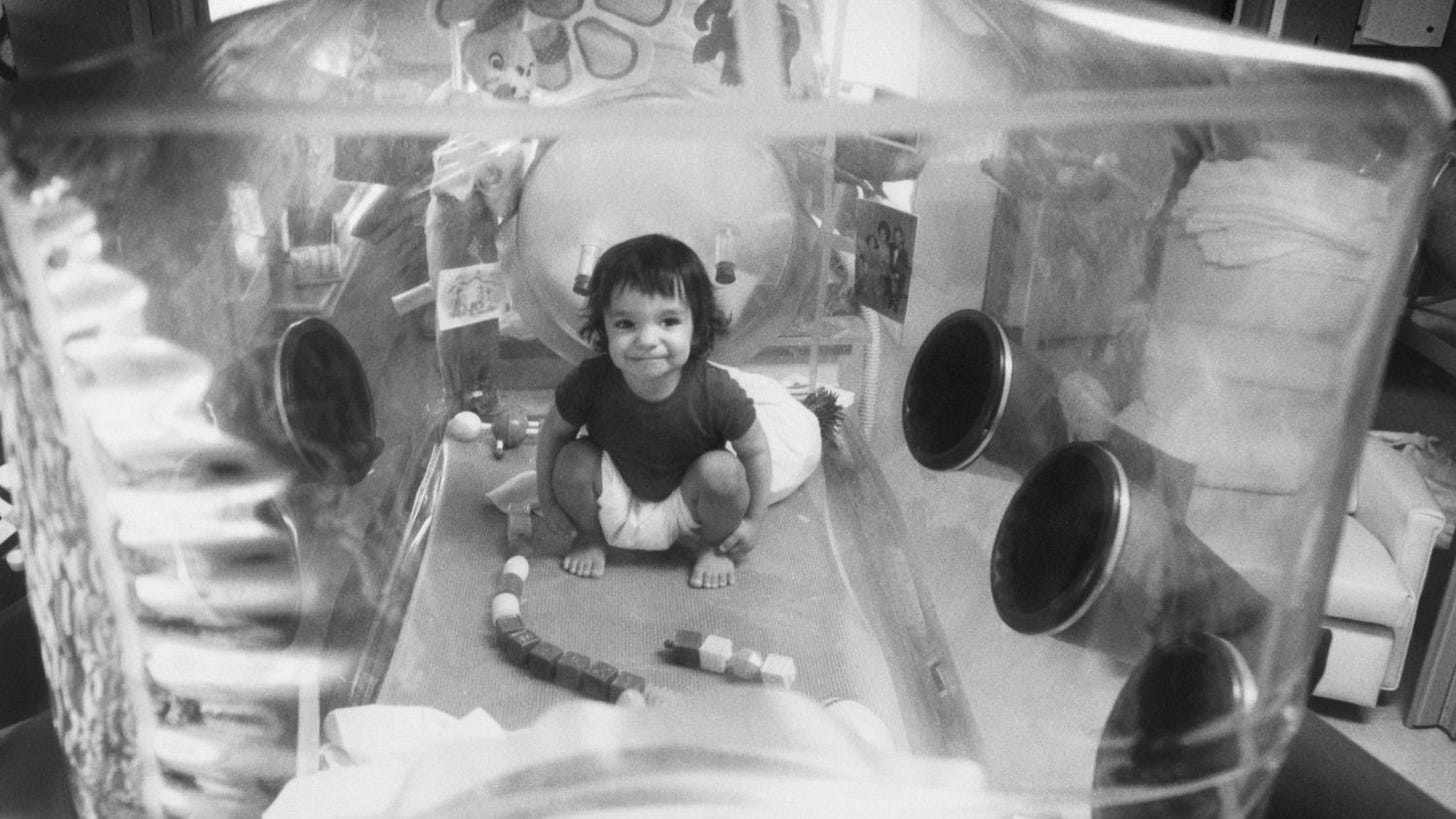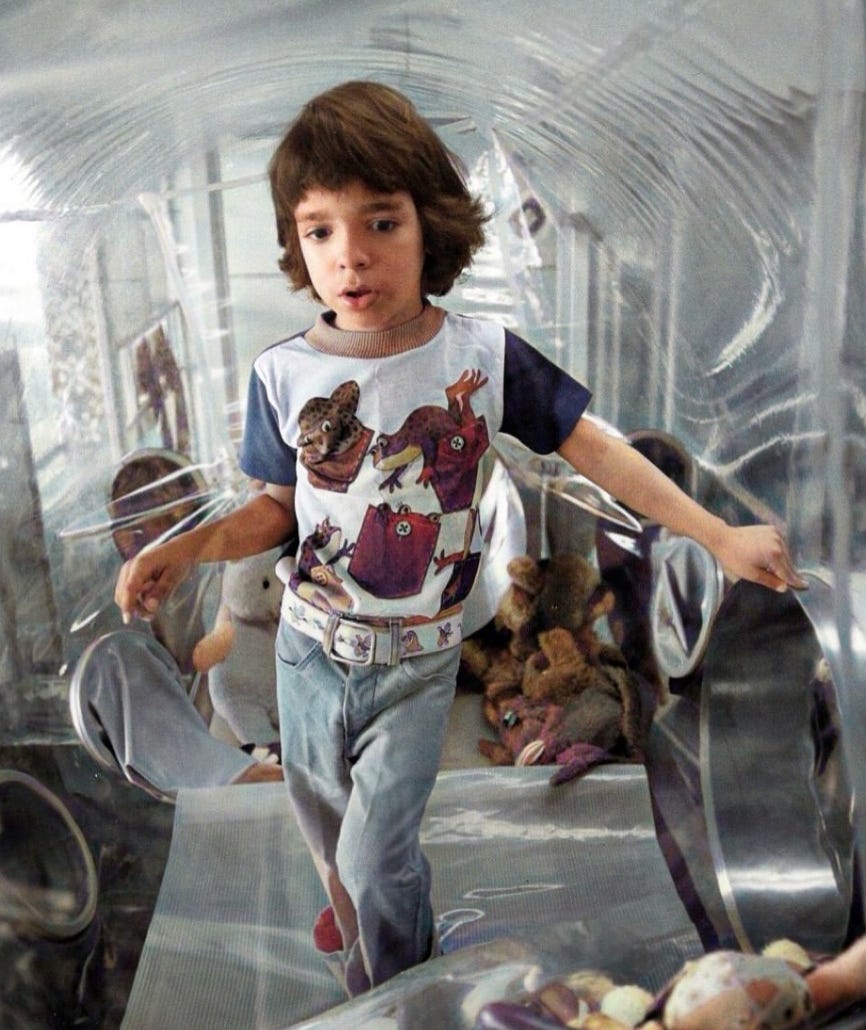On This Day in 1983: The Bubble Boy’s Transplant Gamble and the Ethics of Isolation
David Vetter’s tragic story still forces us to ask the hardest question in medicine: how long should we preserve a life when it means denying the world outside?
Hope Through a Plastic Wall
On 21 October 1983, doctors at Texas Children’s Hospital performed an experimental bone marrow transplant on a 12-year-old boy who had never felt a human touch. His name was David Vetter, better known to the world as “The Boy in the Bubble”.
David was born with Severe Combined Immunodeficiency (SCID), a condition so brutal that the gentlest infection could have killed him. From the moment of his birth, he was sealed inside a sterile plastic isolator. For over a decade, the bubble became his nursery, his classroom, his prison.
That autumn day in 1983, his doctors took a risk. The procedure might offer David a life outside the bubble. But it was a roll of the dice, with everything on the table.
Life in a Plastic Prison
David’s birth was no accident. His parents had already lost one child to SCID, and were told there was a 50% chance of another male child inheriting it. They chose to try again after learning about a biologist in Germany who had successfully raised two SCID boys in isolators. They hoped science would one day catch up with their son’s condition.
When David was born, he was immediately placed into a two-foot isolator. He was baptised using sterilised holy water and touched only through rubber gloves built into the plastic wall. He couldn’t feel warmth. He couldn’t taste air. But he could see, and as he grew, he could speak. By all accounts, he was bright and articulate, with a vocabulary shaped by a hospital ward.
His world expanded as he aged. He was moved from the isolator to a larger sterile hospital room, then eventually into a specially adapted bubble room at home. NASA even built him a mobile “bubble suit” so he could go on short, controlled walks. But the psychological damage was already done.
The suit frightened him. His moods swung between anger and fear. When a trusted doctor left his care, David smeared excrement on the walls of his isolator. He began to fear the very freedom he had once dreamed of.
Hope, Risk and the Brutal Cost of Trying
Doctors had long believed a bone marrow transplant was David’s best chance. But no suitable donor could be found—until his older sister offered hers. It wasn’t a perfect match, but medical advances suggested the body might still accept it.
On 21 October 1983, the procedure went ahead. Doctors worked through the plastic shield. The transplant appeared to go well. David even woke and touched hands with his doctor through the wall, hopeful that the outside world might finally be within reach.
But within weeks, his condition worsened. The donor marrow had carried a dormant virus. David’s fragile system couldn’t fight it. His health declined, and eventually, the unthinkable happened: doctors removed the bubble.
He felt air on his face. He walked barefoot on grass. His family held him. And then, four months later, he died.
What Are We Preserving When We Preserve a Life?
David’s death wasn’t meaningless. The science gained from his case helped develop gene therapies and newborn screening protocols that save lives today. Children with SCID now live full lives, treated early with precise interventions. David’s story changed medical history.
But the deeper question has never gone away.
When is it ethical to keep a child alive in isolation, indefinitely, waiting for science to catch up? David never consented to his confinement. He was a child placed in a clinical limbo, surrounded by cameras, doctors and glass walls.
We marvel at how much was done to save him. But we can’t ignore how much was taken away. He didn’t know the feel of water, of skin, of grass, of being held. For twelve years he lived without those basic human experiences. What is life without them?
It’s easy to be dazzled by medical breakthroughs. It’s harder to confront what David himself once said to a psychologist: “Why did this happen to me? Why am I different?” There’s no pill for that kind of pain.
The Legacy of David Vetter
Since his death in 1984, David’s legacy has shaped immunology. The cause of SCID was identified in his DNA. Screening became standard. Today, many children with SCID are treated before symptoms even appear.
But his story is more than just science. It’s a mirror held up to medical ethics. It asks whether living in a bubble is living at all. And whether the drive to preserve life, at any cost, sometimes crosses a moral line.
His doctors were not villains. They were brilliant, compassionate people working with limited options. But intentions don’t erase outcomes. David wasn’t raised in a hospital. He was raised inside a theory, waiting for proof.
On this day in 1983, hope flowed through a needle into his arm. Four months later, David was gone. But his short life cracked open one of the most difficult truths in medicine: that the line between treatment and cruelty is not always marked clearly. Sometimes it looks like love. Sometimes it looks like care. But sometimes, it looks like plastic.



